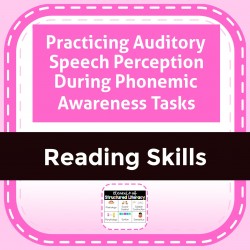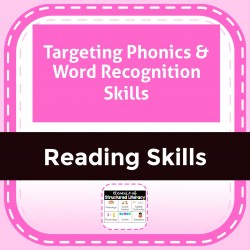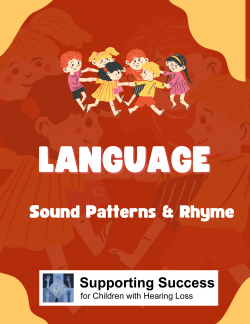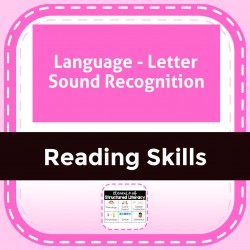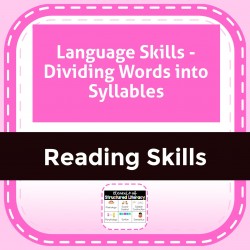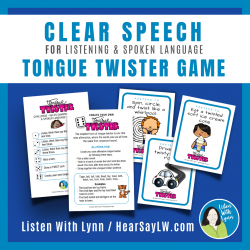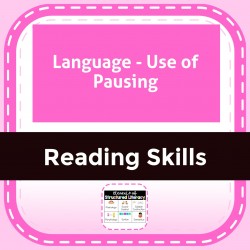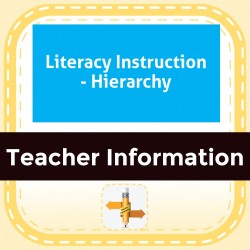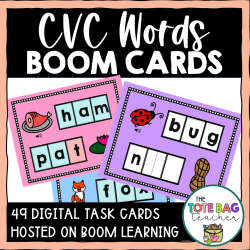Ability Levels
Categories
Resource Types
Age/Grade Range
CCSS
Anchor Standard
Speaking & Listening
Language
Reading
Practicing Auditory Speech Perception During Phonemic Awareness Tasks
$ 295
Information for teachers about the auditory / acoustic components of phonemic awareness, including similarities among vowels and among consonants. Activities include vowel & consonant perception, phon
...
eme isolation(initial, medial and final consonants), phoneme segmentation, and phoneme manipulation. Six levels of difficulty are addressed. Teacher scripts, including 91 word prompts and 108 picture cards.
Targeting Phonics & Word Recognition Skills
$ 195
Support development of foundational reading skills with activities and materials to practice: 1) vowel perception in isolation and in words, phoneme blending and sound-letter association; 2) discrimin
...
ation of vowels in words, sorting long & short vowels.
Language-Sound Patterns & Rhyme
$ 195
Sound patterns within words are used in oral and written language to create emphasis of thought and attention the rhythm and tone of language. Instructional strategies include ideas for teaching word
...
families, riddles, and word family sentences.
Language - Letter Sound Recognition
$ 195
Letter–sound association supports comprehension of the written word. Includes instructional strategies and 3 worksheets.
Language Skills - Dividing Words into Syllables
$ 295
These instructional strategies and activities are designed to introduce and/or reteach identifying syllables. Activities include change the vowel, change the word, number or sounds v. number of letter
...
s, and number of syllables.
TONGUE TWISTER CHALLENGE GAME FOR CLEAR SPEECH
$ 6
Do you have kids who need practice using clear and natural-sounding speech? The Tongue Twister Challenge Game is hilarious and gets kids listening, moving, and engaged! The game sharpens listening and
...
d spoken language skills. It is a game kids ask to play again and again and a must for your toolbox!
The Tongue Twister Challenge Game ➼ Targets CLEAR SPEECH Helps children learn to use natural prosody (rate of speech, volume, intonation, pausing, and fluency. Provides practice to learn to say each syllable and speech sound carefully and precisely.
➼ Develop AUDITORY skills.
Uses the auditory feedback loop. Increases auditory memory and recall. Builds strong phonological awareness skills.
➼ Broadens LANGUAGE skills. Teach the vocabulary used in the tongue twisters.
Reinforces grammar, synonyms, antonyms, and more.
➼ Encourages SOCIAL skills.
Kids practice saying tongue twisters to each other while gaining confidence and interacting in the game.
The Tongue Twister Challenge Game is great for ✧ Tongue Twister Tuesdays ✧ 1:1 Sessions
✧ Small Groups
✧ Class Game
✧ Home Practice
✧ Skill Practice or Review
Includes: • Challenge game cards
• 12 Twist game cards
• 50 tongue twisters • Listen & Spoken Language Tips
◈ ◈ ◈ ◈ ◈ ◈ ◈ ◈ ◈ ◈ ◈ ◈ ◈ ◈ ◈ ◈ ◈ ◈ ◈ ◈ ◈ ◈ ◈ ◈ ◈ ◈ ◈ ◈ ◈ ◈ CUSTOMER TIPS ➼ Questions? EMAIL ME before purchasing this resource or anytime later.
♥ Sign up HERE for the Listen With Lynn Emails
♥ Let’s Connect
Instagram
Facebook Keep up your good work. I am blessed to help along the way.
Thanks so much! Lynn Wood
Language - Use of Pausing
$ 195
In conversation, the use of pausing has several purposes. A speaker may pause and then emphasis the first word in a following phrase to specify meaning in the sentence. Instructional strategies includ
...
ed for basic, intermediate, and advanced readers. Ideas and activities include listening for key words; fluency practice; and progressive sentences.
Literacy Instruction - Hierarchy
$ 0
Information includes the hierarchy of skills and where instruction may need to be adjusted based on the student's current level of understanding.
CVC Words Boom Cards
$ 4
Listening for individual phonemes can be tricky for students who are beginning to read and write. They often will not catch all the sounds, or get them in the incorrect order. That's why I created thi
...
s deck of Boom Cards with self-checking sound boxes. Students can listen to each CVC word and type the individual phonemes they hear. They're self-checking, making them perfect for independent practice, or for small-group work. And because they're PREP-FREE, they are perfect for a busy teacher like yourself. These 49 digital task cards feature 2 CVC words each, for a total of 98 CVC words. Cards are color-coded based on the word's vowel. All words are fill-in-the-blank with each letter self-checking, so learners will know which letter needs to be corrected if needed. All words feature adorable clip art and a sound clip of the spoken word. These digital task cards would be great on a laptop, desktop, Chromebook, tablet, or any other mobile device that can access the internet. They can even be used on your Smart Board. Here’s the best part - they are self-grading and allow you to track student progress. Plus, they’re no prep which means no printing, laminating or storage.What's included:· A link to access 49 Digital Task Cards on the BOOM Learning℠ website· Teacher Notes on how to use these BOOM Cards™ in your classroomTake a look at the thumbnail images and the preview file above to get a better idea of what the digital task cards look like.More about BOOM Learning…To use Boom Cards, you must be connected to the Internet. Boom Cards play on modern browsers (Chrome, Safari, Firefox, and Edge). Apps are available for Android, iPads, iPhones, and Kindle Fires. For security and privacy, adults must have a Boom Learning account to use and assign Boom Cards. You will be able to assign the Boom Cards you are buying with "Fast Pins," (play provides instant feedback for self-grading Boom Cards). Fastplay is always a free way for students to engage with Boom Cards decks. For additional assignment options, you'll need a premium account. If you are new to Boom Learning, you will be offered a free trial of our premium account. Read here for details: http://bit.ly/BoomTrial.
Language - Adjectives: Tell me about it!
$ 495
Describes how adjectives help us more clearly visualize the person, place or thing being described. Includes activities, book suggestions, and 9 worksheets to develop use of adjectives in speech and w
...
riting. Worksheets include: adjective picture cards for pre-k and K-1; color and describe a chair; using comparative and superlative adjectives; create an adjective bank; using cumulative and coordinate adjectives for advanced readersGives an adjective rubric and sample IEP goals.
 Your browser is out of date. For best experience switch to latest updated Browser.
Your browser is out of date. For best experience switch to latest updated Browser.
 Get Chrome
Get Chrome Get Edge
Get Edge Get Firefox
Get Firefox